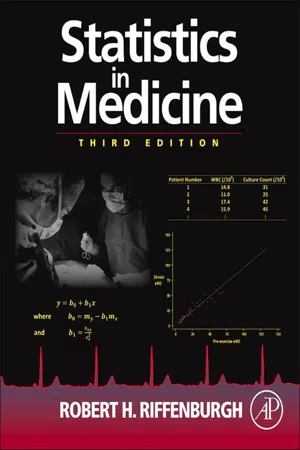
- 738 pages
- English
- ePUB (mobile friendly)
- Available on iOS & Android
Statistics in Medicine
About this book
Statistics in Medicine, Third Edition makes medical statistics easy to understand by students, practicing physicians, and researchers. The book begins with databases from clinical medicine and uses such data to give multiple worked-out illustrations of every method. The text opens with how to plan studies from conception to publication and what to do with your data, and follows with step-by-step instructions for biostatistical methods from the simplest levels (averages, bar charts) progressively to the more sophisticated methods now being seen in medical articles (multiple regression, noninferiority testing). Examples are given from almost every medical specialty and from dentistry, nursing, pharmacy, and health care management. A preliminary guide is given to tailor sections of the text to various lengths of biostatistical courses.- User-friendly format includes medical examples, step-by-step methods, and check-yourself exercises appealing to readers with little or no statistical background, across medical and biomedical disciplines- Facilitates stand-alone methods rather than a required sequence of reading and references to prior text- Covers trial randomization, treatment ethics in medical research, imputation of missing data, evidence-based medical decisions, how to interpret medical articles, noninferiority testing, meta-analysis, screening number needed to treat, and epidemiology- Fills the gap left in all other medical statistics books between the reader's knowledge of how to go about research and the book's coverage of how to analyze results of that researchNew in this Edition: - New chapters on planning research, managing data and analysis, Bayesian statistics, measuring association and agreement, and questionnaires and surveys- New sections on what tests and descriptive statistics to choose, false discovery rate, interim analysis, bootstrapping, Bland-Altman plots, Markov chain Monte Carlo (MCMC), and Deming regression- Expanded coverage on probability, statistical methods and tests relatively new to medical research, ROC curves, experimental design, and survival analysis- 35 Databases in Excel format used in the book and can be downloaded and transferred into whatever format is needed along with PowerPoint slides of figures, tables, and graphs from the book included on the companion site, http://www.elsevierdirect.com/companion.jsp?ISBN=9780123848642- Medical subject index offers additional search capabilities
Frequently asked questions
- Essential is ideal for learners and professionals who enjoy exploring a wide range of subjects. Access the Essential Library with 800,000+ trusted titles and best-sellers across business, personal growth, and the humanities. Includes unlimited reading time and Standard Read Aloud voice.
- Complete: Perfect for advanced learners and researchers needing full, unrestricted access. Unlock 1.4M+ books across hundreds of subjects, including academic and specialized titles. The Complete Plan also includes advanced features like Premium Read Aloud and Research Assistant.
Please note we cannot support devices running on iOS 13 and Android 7 or earlier. Learn more about using the app.
Information
Chapter 1
Planning Studies
From Design to Publication
1.1 Organizing a Study
1.2 Stages of Scientific Knowledge
Stages
The Causative Process is of Interest, Not the Data
Phase I–IV Studies
1.3 Science Underlying Clinical Decision Making
The Scientific Method
Jargon in Science
Evidence
Evidence versus Proof
Evidence-Based Medicine
1.4 Why Do We Need Statistics?
Primary Objective
Population versus Sample
Objective Restated
Table of contents
- Cover image
- Title page
- Table of Contents
- Copyright
- Dedication1
- Dedication2
- Foreword to the Third Edition
- Foreword to the Second Edition
- Foreword to the First Edition
- Acknowledgments
- Databases
- How to Use This Book
- Chapter 1. Planning Studies
- Chapter 2. Planning Analysis
- Chapter 3. Probability and Relative Frequency
- Chapter 4. Distributions
- Chapter 5. Descriptive Statistics
- Chapter 6. Finding Probabilities
- Chapter 7. Confidence Intervals
- Chapter 8. Hypothesis Testing
- Chapter 9. Tests on Categorical Data
- Chapter 10. Risks, Odds, and ROC Curves
- Chapter 11. Tests on Ranked Data
- Chapter 12. Tests on Means of Continuous Data
- Chapter 13. Multi-Factor ANOVA and ANCOVA
- Chapter 14. Tests on Variability and Distributions
- Chapter 15. Managing Results of Analysis
- Chapter 16. Equivalence Testing
- Chapter 17. Bayesian Statistics
- Chapter 18. Sample Size Estimation and Meta-Analysis
- Chapter 19. Modeling Concepts and Methods
- Chapter 20. Clinical Decisions Based on Models
- Chapter 21. Regression and Correlation
- Chapter 22. Multiple and Curvilinear Regression
- Chapter 23. Survival, Logistic Regression, and Cox Regression
- Chapter 24. Sequential Analysis and Time Series
- Chapter 25. Epidemiology
- Chapter 26. Measuring Association and Agreement
- Chapter 27. Questionnaires and Surveys
- Chapter 28. Methods You Might Meet, But Not Every Day
- Answers to Chapter Exercises
- Tables of Probability Distributions
- Refernces and Data Sources
- Symbol Index
- Statistical Subject Index
- Medical Subject Index